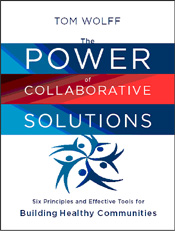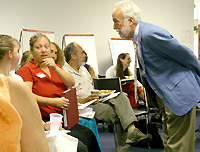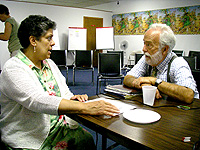Social Determinants of Health and Mental Health: Why Not? May 24, 2012
Posted by tomwolff in : Coalition Building, Collaborative Solutions , 1 comment so farThe concept of Social Determinants of Health (SDOH) is widely used and accepted as a way of understanding health, especially in the world of Public Health. Social Determinants of Health are the “conditions and environments in which people are born, grow, live, eat work and age as well as their access to the care system” (CDC). The premise behind Social Determinants of Health is that our health is determined by much more than our access to health care and our health behaviors but also by the powerful forces in our environment such as:
- Socio economic status
- Environmental exposure
- Education
- Employment
- Housing
- Access to food,
- Transportation
- Social capital, and
- Public safety.
Social Determinants of Health account for almost 80% of our health. Access to health care actually only accounts for around 10% of our health. There is solid research to back up the impact on health in each of these arenas. The punch line is that our zip code may be more important than our genetic code for our health. A social determinants of health approach allows for a broad, ecological, community wide, understanding of our health and an equally broad approach to interventions to modify these numerous systems to improve health.
So, the question for this Newsletter is, “ why isn’t this simple common sense framework being applied as broadly to mental health as it is to physical health?” There was a conference at the Adler School of Professional Psychology in 2010 that was focused on this topic.(See The Social Determinants of Mental Health: From Awareness to Action June 3-4, 2010 http://www.amazon.com/The-Social-Determinants-Mental-Health/dp/1456324160). But, short of this, the literature on this topic is minimal. This is puzzling since on the face of it mental health seems even more amenable to a SDOH understanding than physical health.
One of the first things I learned in Psychology 101 was that behavior is a function of the organism and the environment. However, as I proceeded in my undergraduate and graduate training, the focus was more and more on the person/organism side of the equation and less on the environment. In spite of this, in my early work as a psychotherapist on a university campus the link was actually quite obvious. Life stresses had an impact on the well being of my clients. The Viet Nam veterans returning to college brought their war experiences to the campus (in the form of what would later be labeled Post Tramautic Stress Disorders). Mothers of young children living in graduate student housing found managing their lives and their children with very little money to be quite stressful. In these cases we went beyond providing psychotherapy but to building community prevention programs for these groups and modifying their physical environment (i.e. building a playground for the children in the married student housing).
After I left the campus, I worked in Consultation, Education and Prevention in a Community Mental Health Center (CMHC) -remember them?. Here again the approach was a SDOH approach (even though we did not know the language then). For me it was an approach deeply embedded in my training and experience as a community psychologist with a premise that behaviors needed to be understood in their context and the eco-system of the individuals. The community psychology approach empowers populations to solve their own problems. Community psychology is committed to developing prevention approaches that include structural and systems change
With all this background in the community mental health movement in the 60s and 70s, you would think that the field of mental health would have been ripe for embracing and championing the SDOH approach to mental health that is the present hot trend in public health. But no!
Along the way, something interesting and distressing happened. Mental health issues became the business of mental illness, and mental illness became conceptualized as a biological illness cured by powerful and profitable medications. A SDOH approach to mental health and mental illness is a direct threat to the model that declares mental illness a biological disorder cured by drugs.
I can hear the echo of one of my mentor’s, George Albee’s words, predicting the biologization of mental health. First, President Reagan turned the national community mental health system that was federally funded into state mental health block grants. What the states knew about was dealing with the chronically mentally ill, so there was no place for prevention, consultation and education in the mental health system and those services disappeared very rapidly under block grants. That is the equivalent of a comprehensive health system eliminating public health. Then, the National Institute of Mental Health shifted from support of CMHCs to funding for research on the biological origins of mental illness. At that point the drug companies moved in and supported these efforts. The Alliance for the Mentally Ill (AMI), mainly composed of the families of the mentally ill, became a strong voice for the chronically mentally ill. Interestingly, their major funding source was the pharmaceutical companies. So, all the stars aligned to move the mental health system away from a SDOH community mental health perspective and towards a biological perspective. And, there has been no turning back.
The widespread endorsement of SDOH by public health may be a chance to bring the pendulum back a bit and to start addressing alternative ways of understanding emotional well being and other ways of intervening and preventing disorders.
If we all embraced a SDOH perspective on mental health, what would that look like?
First, researchers would have to lay the ground work by gathering the studies
on each of the social determinants of health and its relationship to mental health. For example: What is the impact on unemployment or underemployment to one’s emotional well being? How does nutrition and fitness affect one’s mental health?
In the arena of health, an early British publication entitled “ The Solid Facts”
http://www.euro.who.int/__data/assets/pdf_file/0005/98438/e81384.pdf laid out the research to back up each social determinant of health in a clear and concise manner – very readable for stakeholders and policy makers. This is what is needed now for SDOH and mental health.
Second, for each SDOH we would need to present approaches that can modify these social determinants in such a way that it can improve the mental health of the population. These can be programs, policies or structural changes. Two recent issues that touch on major social determinants of health come to mind: At the moment there is a significant amount of focus on Food and Fitness policy . What has been found about improving food and fitness and its impact on mental health? Another hot issue at the moment regards housing; we could look at various foreclosure interventions and their impact on mental health.
So, we need a sophisticated look at how to create changes in each social determinant of health that can improve mental well being.
Finally, we need settings which can address mental health from a SDOH perspective.
Where can this work be carried out and supported? Who will step up to the plate? Mental Health agencies? Public Health agencies? Academia? Healthy Community initiatives? Or, will we need to create new settings. Without settings to support SDOH and mental health, we will make little progress.
A story that summarizes the issue well:
Early in my career, I went to do a focus group with some community elders. I asked them “What are the major issues they face in their lives?” They responded: money (not enough), access to affordable health care, and lack of transportation. Then, I explained that I was from a mental health agency and asked what issues in their life most affected their mental health. They said : ‘Doc weren’t you listening : money (not enough), access to affordable health care, and lack of transportation.’
Even back then, they understood the relationship of SDOH to their mental well being. Now, we need to catch up with them.
1 comment so farManaging competition and turf in coalitions: Ask Dr. Coalition November 15, 2011
Posted by tomwolff in : Coalition Building, Collaborative Solutions, Uncategorized , add a commentDear Dr. Coalition,
In my local coalition all the organizational members talk about working for the good of the community. But in reality they are driven by their own self interest. They spend much of their coalition time protecting their territory. Turf wars seem to dominate.
So we really don’t identify what the community needs and coordinate our resources for the good of the community
Any ideas?
Frustrated by turf wars in Illinois
Dear Frustrated,
A clear and explicit goal of coalitions is often to promote coordination, cooperation and collaboration. – to do together that which we cannot do apart. But it comes as no surprise that turf, territoriality and competition among coalition members is a major barrier to coalition success. The capacity of one organization to feel competitive with another often amazes me.
This competition can be just among health and human service agencies as the compete for clients and contracts , but it also can be between private sector and public sector, between local government and state government, or between local government and the community. A new request to provide a service might be issued by the state and two or three different agencies – all members of the same coalition- might begin to compete for that contract, seemingly undermining the coalition’s goal of cooperation.
One would hope that having declared themselves wanting to be part of a coalition, these turf battles would decline – but instead they often escalate.
So what can we do?
A good clear first step is to create a common vision (see The Power of Collaborative Solutions for an easy visioning exercise). This will set up your common goal for all to see.
Then identify (brainstorm) the steps that are needed to reach the vision. This will set out some doable steps that you can take together.
Use priority dots to pick your starting point. Next you are off and running in a direction to meet the community’s needs and hopefully reduce the turf issues.
Here is the bottom line: I know it may sound like heresy to say this, but we need to get competition out of the helping system; it seems to cause much more harm than good. Competition and helping do not necessarily go well together. We need to replace competition with cooperation and collaboration.
Dr Coalition
Dear Reader: What would you suggest to Frustrated in Illinois?
And what coalition dilemmas are you struggling with?
Please comment below:
Add a commentHelp I am trapped in a Coalition and can’t get out: Meet Dr.Coalition September 26, 2011
Posted by tomwolff in : Coalition Building, Collaborative Solutions , add a commentSo let’s ask Dr Coalition about what traps us in coalitions where there is a failure to act and what we can do to turn that around.
Dear Dr. Coalition,
I am in a coalition that talks, talks, talks but never acts. This failure to act makes me feel trapped. The members of our coalition can talk about issues endlessly. If anyone suggests taking action they urge them to first do a careful needs assessment, even though we have shelves of these assessments already. It is almost as if they don’t know how to take action or are afraid of taking any action. What can we do?
Sincerely,
Exasperated in Ohio
Dear Exasperated,
I’ve seen it all as well– coalitions are creative in finding ways to put off being catalysts for community change and moving to action to change programs, policies and practices in their communities. I have seen coalitions:
- Spend a year writing by-laws and incorporating (to what end?
- Conduct another round of needs assessments when they already have all the data they need
- Write reports summarizing their findings – reports that get placed on the shelf next to earlier reports but no one plans actions to follow up on the identified needs
- Spend all their time networking and exchanging information with each other without ever moving to the next levels of collaborative functioning – coordinating, cooperating and collaborating – these later three can create actions that move towards actual community change
So how do we get stuck coalitions to move to action? Here are some ideas:
First, identify that the lack of action is a problem that many members are experiencing (just ask them!). The literature on successful coalitions says that one of the key variables in successful coalitions is that “outcomes matter”. So tap into that sentiment among your members – that they joined the coalition and continue to commit time to it in order to create community change.
Then together identify some “low hanging fruit” – easy win situations where they can start to act together – they need to see that the core premise of coalitions will work for them – namely “That they can do together that which that they cannot do apart”. They won’t believe that until they act together and get something done.
One helpful tool is “The Continuum of Collaboration Worksheet”. This allows a coalition to assess whether they are mainly doing “networking” which does not involve taking action or whether they have moved on to other more powerful forms of coalition action – namely “coordination” “cooperation” or “collaboration”. This tool, based on Arthur Himmelman’s definitions, is available in The Power of Collaborative Solutions p. 52 ( https://www.tomwolff.com/healthy-communities-tools-and-resources.html) and also on my website (https://www.tomwolff.com/collaborative-solutions-newsletter-summer-05.htm#resources).
In future blogs Doctor Coalition will tackle other common coalition issues, such as:
- Lack of a common vision
- Failure to provide and create collaborative leadership
- Costs outweigh the benefits
- Minimal organizational structure
- Turf and Competition
- Bad history
- Not engaging self-interest
- Over-coalitioned communities
Please send Doctor Coalition the coalition dilemmas and issues that you are struggling with.
Comment on your ideas on how to address failure to act or pose your own dilemma below.
Add a commentThe Power of Collaborative Solutions – the early foundations January 24, 2011
Posted by tomwolff in : Coalition Building, Collaborative Solutions , add a comment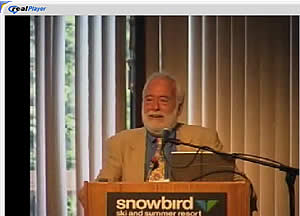 Coalition beginnings and why they matter
Coalition beginnings and why they matter
How did your coalition start up? What was the driving force? And does that piece of history really matter now?
Coalitions start up in many ways. Some emerge organically from the community in response to a crisis. Others result from a funding opportunity that requires a “partnership”. So does it matter how your coalition began and what the driving force was? Can it still matter years later? The answer is emphatically “Yes”. History matters.
I recently presented at a conference on coalitions, “Stronger Together: The Power of Collaborative Solutions for Building Healthy Communities”, organized by the Non-Profit Center of Milwaukee. Following my keynote I was the discussant for a panel of local coalitions. Our first question for the panelists concerned the driving force that led to their coalition starting up. The answers were fascinating for their variety:
- One started as a mandate from a federal funding source with the responsibility for distributing federal funds locally.
- Another was a response to a local crisis, namely an increase in local homicides
- A third emerged from facility, and space pressures faced by an agency that they couldn’t solve on their own. So they brought in partners to share space and programming
- A fourth was a Mayor’s initiative in response to the local foreclosure crisis
- And the final example emerged from neighborhoods and settlement houses focusing on youth
As our discussion proceeded it became apparent that history matters. As a clinician I was trained to understand the histories of my clients, so I brought that assumption to my coalition work and found that here too we need to understand the history of our communities and our coalitions.
Some examples:
The early role of the grassroots: Coalitions that start from grassroots community action carry that legacy and its’ commitment to having residents at the table as powerful partners. Even as they add the provider community that legacy remains. Whereas coalitions that begin as agency or government driven will often add residents later on but their history of being aa after thought often has residents feeling as if they are second class citizens and can be hard to overcome (although I have seen it done).
The early role of funding: Some coalitions start around funding; others start around a community need and have no money. This also creates a legacy. When the funded coalition loses its money it often closes down – it cannot imagine doing business without funding and staff. Whereas grassroots coalitions that get money and then lose it can return to its original roots of operating without funding.
So how has history of your beginnings left a legacy for your coalition?
To comment click “Add a Comment“.
Add a commentThe Power of Collaborative Solutions – Global applications January 14, 2011
Posted by tomwolff in : Coalition Building, Collaborative Solutions , 1 comment so farOut of the Box Prize: Now YOU can help choose the winners from among ten amazing global innovations.
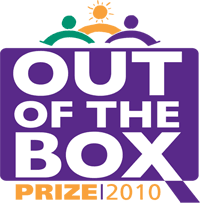 For many years I have been a partner and contributor with the Community Tool Box (CTB) (ctb.edu.ku) team on the development of this rich web site with 7,000 pages of free downloadable material on community health and development. The CTB is used by hundreds of thousands community members from around the world.
For many years I have been a partner and contributor with the Community Tool Box (CTB) (ctb.edu.ku) team on the development of this rich web site with 7,000 pages of free downloadable material on community health and development. The CTB is used by hundreds of thousands community members from around the world.
With this global view in mind, the CTB established the Out of the Box Prize to honor innovative approaches to promoting community health and development worldwide. By the closing date of October 31, we were overwhelmed by the positive response we had received – more than 300 groups from 42 countries had applied! Applicants came in from around the globe – from the Americas to Zambia, and many countries in between. Applicants’ work included efforts to improve community health and development in a variety of creative ways — addressing issues of importance to communities including the environment, HIV/AIDS, addressing Millennium Development Goals, rallying neighborhoods together for change, and improving the public’s health.
Now all of you can be part of the process of picking the top finalists! After making difficult decisions our international panel of judges has narrowed the list to the top ten and now it is time for the public to pick the finalist. So become part of the process. You can review the inspiring innovations of the ten finalists by visiting http://ctb.ku.edu/en/out_of_the_box/finalists.aspx. We also invite you to vote for up to three of your favorite projects to receive the Grand Prize of $5,000 or the Second Prize of $2,000. To vote, simply go to http://www.surveymonkey.com/s/PCMD7Z8. (Voting ends on January 31, 2011 and winners will be announced February 15, 2011.)
You will really enjoy reading about these amazing community innovations.
As someone who read many of the applications a number of trends in the best submissions struck me:
They are asset based – They demonstrate deep respect for the communities they worked with. The start with the assumption that the residents have the skills to do the work.
They employ grassroots models: The interventions were delivered by the community residents themselves.
They promoted clear cost effective solutions.
Sustainability was built in – the interventions were designed to be self sustaining from the start
They took a community wide perspective .They understood the vast scope of the issues and that the problems the sought to address exist in a context of the broader social determinants of health.
So which of the top ten inspired you the most?
To comment click “Add a Comment“
To read comments click here Read a Comment
1 comment so far


